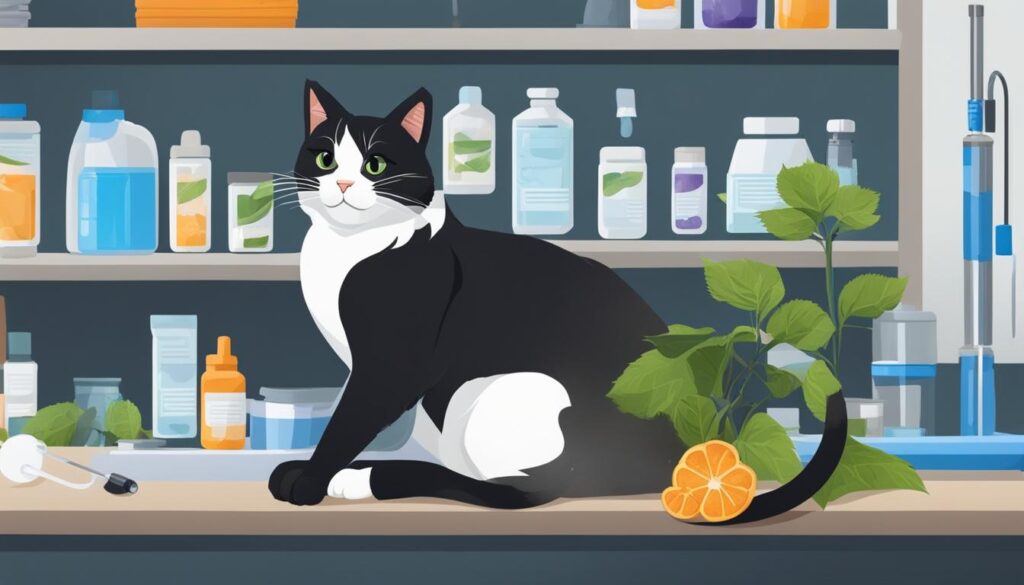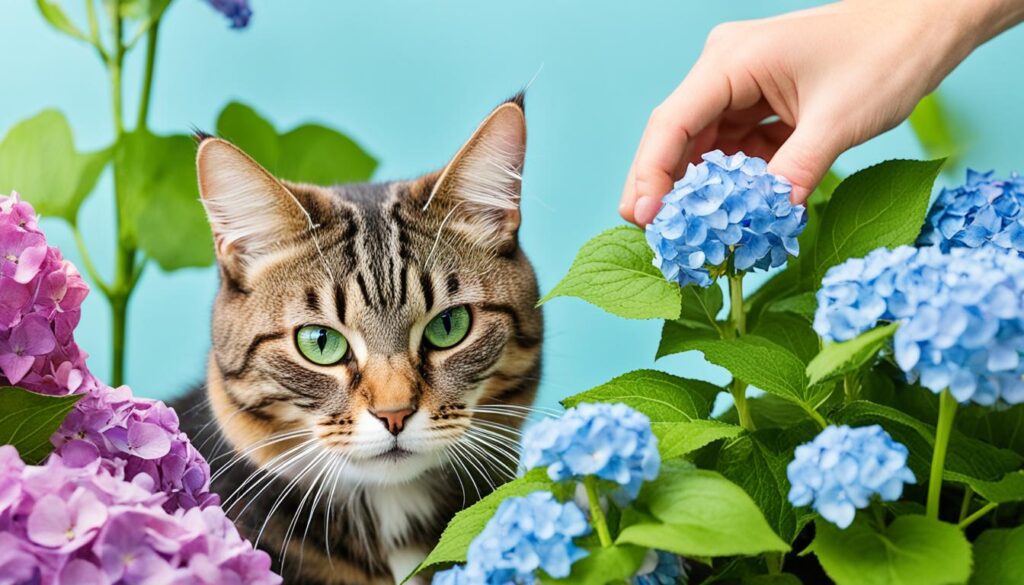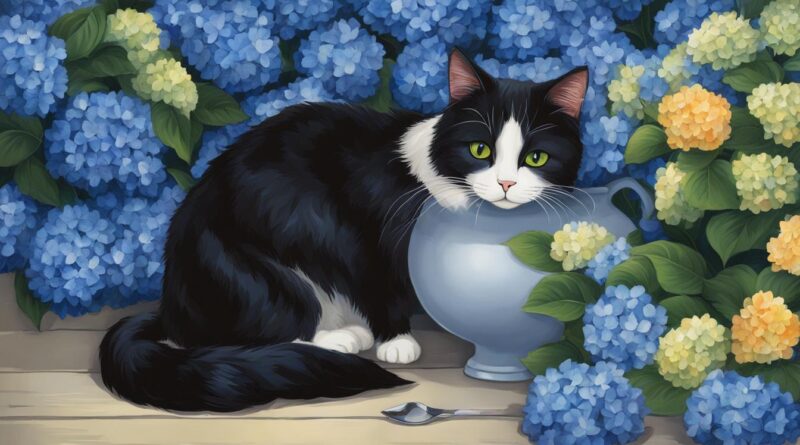Are Hydrangeas Poisonous to Cats? Safety Guide
Hydrangeas, with their stunning and colorful flowers, are a popular choice for many garden enthusiasts. However, if you have a feline friend at home, it’s essential to know whether these beautiful plants pose any danger to them.
So, are hydrangeas poisonous to cats? The answer is yes. Hydrangeas, also known as hortensia plants, contain toxins that can be harmful to our furry companions. All parts of the hydrangea plant, including the leaves and flowers, contain a toxic component called amygdalin, a cyanogenic glycoside. These toxins have the potential to cause cyanide poisoning in cats, although severe cases are rare.
If your cat ingests any part of a hydrangea plant, it’s crucial to seek immediate veterinary care. Even mild poisoning can lead to stomach upset, and prompt treatment is necessary to ensure your cat’s well-being.
Key Takeaways:
- Hydrangeas are toxic to cats due to the presence of cyanogenic glycosides.
- All parts of the hydrangea plant, including the leaves and flowers, contain toxins.
- If you suspect your cat has ingested a hydrangea plant, consult with a veterinarian immediately.
- Prompt treatment is necessary to prevent complications from cyanide poisoning.
- Prevent access to hydrangea plants and consider cat-friendly alternatives in your garden to ensure your cat’s safety.
Signs of Hydrangea Poisoning in Cats
Recognizing the signs of hydrangea poisoning in cats is crucial for prompt diagnosis and treatment. The symptoms may manifest as:
- Loss of appetite: Cats affected by hydrangea poisoning may display a sudden lack of interest in food.
- Vomiting: Cats may experience recurrent episodes of vomiting, which can further contribute to dehydration.
- Diarrhea: Hydrangea poisoning can cause diarrhea, leading to dehydration and electrolyte imbalances.
- Painful belly: Cats may exhibit abdominal discomfort or tenderness due to the poisonous effects of hydrangeas.
- Depression: The ingestion of hydrangea plants can cause cats to become lethargic and exhibit signs of depression.
- Difficulty breathing: In severe cases of cyanide poisoning, cats may experience labored breathing or respiratory distress.
If your cat shows any of these symptoms or you suspect they have ingested a hydrangea plant, it is essential to consult with a veterinarian immediately for proper diagnosis and treatment.
Case Study: Cat with Hydrangea Poisoning
“My cat, Bella, displayed sudden loss of appetite and started vomiting after chewing on a hydrangea flower. Worried about her condition, I rushed her to the veterinary clinic. The veterinarian confirmed hydrangea poisoning and provided immediate treatment. Bella was hospitalized for supportive care, including intravenous fluids and medications to alleviate her symptoms. Thanks to the timely intervention, Bella made a full recovery within a few days.” – Jane, cat owner.
| Signs of Hydrangea Poisoning | Treatment |
|---|---|
| Loss of appetite | Supportive care, fluids, medications |
| Vomiting | Fluid therapy, antiemetics |
| Diarrhea | Fluid therapy, gastrointestinal protectants |
| Painful belly | Analgesics, monitoring |
| Depression | Supportive care, environmental enrichment |
| Difficulty breathing | Oxygen therapy, supportive measures |
Treatment and Prognosis of Hydrangea Poisoning in Cats
In the unfortunate event that your cat has been exposed to hydrangea poisoning, prompt and appropriate treatment is essential for their well-being. Although there is no specific antidote for hydrangea poisoning in cats, there are measures that can be taken to manage the symptoms and improve the prognosis.
In mild cases of hydrangea poisoning, supportive care is usually sufficient. This includes providing your cat with fluids to prevent dehydration and medications to alleviate symptoms such as vomiting and diarrhea. It is important to monitor your cat closely and ensure they have a calm and comfortable environment to aid in their recovery.
However, in severe cases of hydrangea poisoning, more aggressive treatment may be required. This can involve inducing vomiting to remove any remaining plant material from the cat’s stomach, as well as performing gastric lavage (stomach pumping) to thoroughly cleanse their digestive system. Hospitalization for further supportive care, such as intravenous fluids and additional medication, may also be necessary.
The prognosis of hydrangea poisoning in cats is generally good, especially if treatment is initiated promptly. With appropriate care and intervention, most cats are able to recover fully from hydrangea poisoning. However, the severity of the poisoning, the amount ingested, and the overall health of the cat can affect the prognosis.
It is important to consult a veterinarian as soon as you suspect your cat has ingested any part of a hydrangea plant. They will be able to provide the necessary guidance and treatment tailored to your cat’s specific condition.

| Treatment and Prognosis of Hydrangea Poisoning in Cats |
|---|
| Supportive care, including fluids and medications to alleviate symptoms |
| Induced vomiting and gastric lavage in severe cases |
| Hospitalization for further supportive care, such as intravenous fluids |
| Prognosis is generally good with prompt treatment |
Prevention of Hydrangea Poisoning in Cats
To ensure the safety of our feline friends, it is essential to take preventive measures to avoid hydrangea poisoning in cats. By implementing the following cat-friendly garden tips, you can keep your cats away from toxic plants and create a safe environment for them to roam:
- Keep hydrangea plants out of reach: Place hydrangeas in locations where cats cannot climb or access them. Consider hanging baskets or elevated planters to keep them away from curious paws.
- Eliminate toxic plants from your garden: Take the time to identify and remove any toxic plants from your garden, including those that are harmful to cats. This will help prevent accidental ingestion and potential poisoning.
- Utilize non-toxic botanical oil sprays: Consider using non-toxic botanical oil sprays, which can be applied to your garden plants to deter cats from approaching them. These sprays emit scents that cats find unpleasant, helping to keep them away from potential hazards.
- Install motion-activated sprinklers or ultrasonic deterrents: For outdoor gardens, you can install motion-activated sprinklers or ultrasonic deterrents to keep cats away from toxic plants. These devices are triggered by motion and emit a burst of water or high-frequency sound, effectively deterring cats from approaching the area.
- Keep cats indoors or provide a catio: If your cat spends time outdoors, consider keeping them indoors or providing them with a secure catio. This enclosed outdoor space allows cats to enjoy fresh air and natural surroundings while keeping them away from toxic plants.
By implementing these cat-friendly garden tips, you can create a safe and enjoyable environment for your cats, free from the risk of hydrangea poisoning and other toxic plant exposures.

“Creating a cat-friendly garden is essential for keeping our feline friends safe from toxic plants. By following these preventive measures, you can ensure a peaceful and secure environment for your beloved cats.”
Alternatives to Hydrangeas in a Cat-Friendly Garden
If you want to create a cat-friendly garden, it’s important to choose plants that are safe for your furry friends. Fortunately, there are many cat-friendly plants available that can add beauty to your garden without posing any harm to your beloved cats. Here are some safe and non-toxic plants that you can consider:
1. Catnip
Catnip is a well-known favorite among cats. Its pleasant scent and stimulating effects make it an excellent addition to a cat-friendly garden. Whether you grow it in pots or directly in your garden, catnip will provide endless entertainment for your feline companions.
2. Cat Grass
Cat grass is another popular choice for cat-friendly gardens. It provides cats with a safe and natural source of fiber, aiding in digestion and preventing the ingestion of potentially harmful plants. Cat grass is easy to grow and maintain, making it a convenient option for any garden.
3. Spider Plants
Spider plants are not only visually appealing but also safe for cats. These resilient and low-maintenance plants can withstand various conditions, making them an ideal choice for both indoor and outdoor gardens. Just be mindful of their dangling leaves, as some cats may be tempted to play with them.
4. Boston Ferns
Boston ferns offer a lush and tropical touch to your garden while remaining safe for cats. These elegant plants thrive in shady areas and are easy to care for. Their vibrant green fronds create a soothing atmosphere, providing a tranquil retreat for both you and your cats.
5. African Violets
African violets add a splash of color to any cat-friendly garden. These compact plants produce vibrant and delicate flowers, creating a beautiful focal point. African violets are non-toxic to cats, allowing you to enjoy their beauty worry-free.
6. Table: Comparison of Cat-Friendly Plants
| Plant | Features |
|---|---|
| Catnip | Stimulating effects, entertainment for cats |
| Cat Grass | Natural source of fiber, aids digestion |
| Spider Plants | Resilient, visually appealing |
| Boston Ferns | Lush foliage, tropical touch |
| African Violets | Colorful flowers, vibrant beauty |
When selecting plants for a cat-friendly garden, always ensure that they are non-toxic and safe for cats. Additionally, avoid using any fertilizers, pesticides, or chemicals that could potentially harm your furry friends. By creating a cat-friendly garden, you can provide a safe and enjoyable outdoor space for both you and your beloved cats.
Conclusion
In conclusion, it is important for cat owners to be aware of the potential dangers that hydrangeas can pose to their feline companions. Hydrangeas are poisonous to cats, and it is crucial to take precautions to keep our cats safe.
Preventing access to hydrangea plants is the first step in ensuring feline safety. By placing these plants in locations where cats cannot reach or climb them, we can effectively minimize the risk of poisoning.
Recognizing the signs of hydrangea poisoning is also essential. Loss of appetite, vomiting, diarrhea, and depression are some of the common symptoms of cyanide poisoning in cats. If these signs are observed, it is crucial to seek prompt veterinary care for proper diagnosis and treatment.
Creating a cat-friendly garden with non-toxic plants is another important measure. By choosing cat-safe flowers and plants, such as catnip, cat grass, spider plants, Boston ferns, and African violets, we can ensure that our gardens remain beautiful while keeping our cats protected from potential hazards.
By implementing these precautions, cat owners can enjoy the beauty of hydrangeas and other plants while prioritizing the safety and well-being of their beloved feline companions.
FAQ
Are hydrangeas poisonous to cats?
Yes, hydrangeas are toxic to cats. All parts of the plant contain amygdalin, a cyanogenic glycoside that can cause cyanide poisoning in cats.
What are the symptoms of hydrangea poisoning in cats?
The symptoms of hydrangea poisoning in cats may include loss of appetite, vomiting, diarrhea, painful belly, depression, and difficulty breathing in severe cases of cyanide poisoning.
How is hydrangea poisoning in cats treated?
There is no specific antidote for hydrangea poisoning in cats. Treatment involves managing the symptoms and removing the source of poisoning from the cat’s system. Mild cases may only require supportive care, while severe cases may require induced vomiting, gastric lavage, and hospitalization.
What is the prognosis for cats with hydrangea poisoning?
The prognosis for cats with hydrangea poisoning is generally good, especially if treatment is sought early.
How can I prevent hydrangea poisoning in cats?
To prevent hydrangea poisoning in cats, keep the plants out of their reach and avoid exposing cats to other toxic plants. You can also use non-toxic botanical oil sprays, motion-activated sprinklers, or ultrasonic deterrents to keep cats away from the plants.
What are some alternatives to hydrangeas in a cat-friendly garden?
Some cat-friendly plants include catnip, cat grass, spider plants, Boston ferns, and African violets. Make sure to research and choose plants that are non-toxic to cats.


